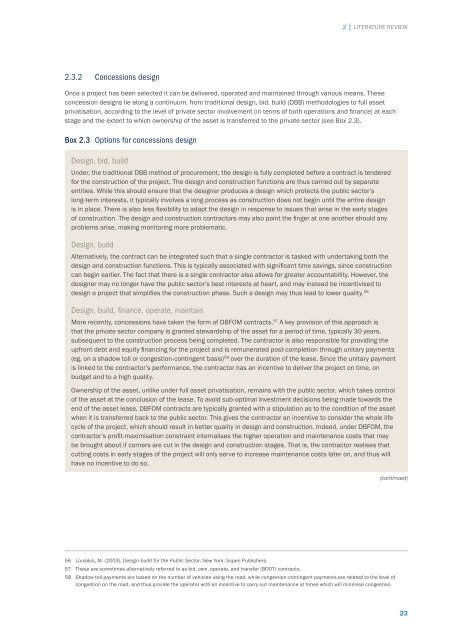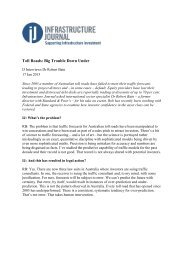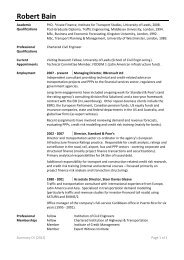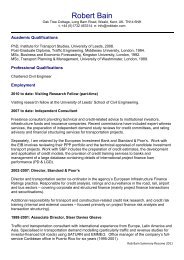Disincentivising overbidding for toll road concessions
Disincentivising overbidding for toll road concessions
Disincentivising overbidding for toll road concessions
- No tags were found...
You also want an ePaper? Increase the reach of your titles
YUMPU automatically turns print PDFs into web optimized ePapers that Google loves.
2 │ LITERATURE REVIEW<br />
2.3.2 Concessions design<br />
Once a project has been selected it can be delivered, operated and maintained through various means. These<br />
concession designs lie along a continuum, from traditional design, bid, build (DBB) methodologies to full asset<br />
privatisation, according to the level of private sector involvement (in terms of both operations and finance) at each<br />
stage and the extent to which ownership of the asset is transferred to the private sector (see Box 2.3).<br />
Box 2.3 Options <strong>for</strong> <strong>concessions</strong> design<br />
Design, bid, build<br />
Under, the traditional DBB method of procurement, the design is fully completed be<strong>for</strong>e a contract is tendered<br />
<strong>for</strong> the construction of the project. The design and construction functions are thus carried out by separate<br />
entities. While this should ensure that the designer produces a design which protects the public sector’s<br />
long-term interests, it typically involves a long process as construction does not begin until the entire design<br />
is in place. There is also less flexibility to adapt the design in response to issues that arise in the early stages<br />
of construction. The design and construction contractors may also point the finger at one another should any<br />
problems arise, making monitoring more problematic.<br />
Design, build<br />
Alternatively, the contract can be integrated such that a single contractor is tasked with undertaking both the<br />
design and construction functions. This is typically associated with significant time savings, since construction<br />
can begin earlier. The fact that there is a single contractor also allows <strong>for</strong> greater accountability. However, the<br />
designer may no longer have the public sector’s best interests at heart, and may instead be incentivised to<br />
design a project that simplifies the construction phase. Such a design may thus lead to lower quality. 56<br />
Design, build, finance, operate, maintain<br />
More recently, <strong>concessions</strong> have taken the <strong>for</strong>m of DBFOM contracts. 57 A key provision of this approach is<br />
that the private sector company is granted stewardship of the asset <strong>for</strong> a period of time, typically 30 years,<br />
subsequent to the construction process being completed. The contractor is also responsible <strong>for</strong> providing the<br />
upfront debt and equity financing <strong>for</strong> the project and is remunerated post-completion through unitary payments<br />
(eg, on a shadow <strong>toll</strong> or congestion-contingent basis) 58 over the duration of the lease. Since the unitary payment<br />
is linked to the contractor’s per<strong>for</strong>mance, the contractor has an incentive to deliver the project on time, on<br />
budget and to a high quality.<br />
Ownership of the asset, unlike under full asset privatisation, remains with the public sector, which takes control<br />
of the asset at the conclusion of the lease. To avoid sub-optimal investment decisions being made towards the<br />
end of the asset lease, DBFOM contracts are typically granted with a stipulation as to the condition of the asset<br />
when it is transferred back to the public sector. This gives the contractor an incentive to consider the whole life<br />
cycle of the project, which should result in better quality in design and construction. Indeed, under DBFOM, the<br />
contractor’s profit-maximisation constraint internalises the higher operation and maintenance costs that may<br />
be brought about if corners are cut in the design and construction stages. That is, the contractor realises that<br />
cutting costs in early stages of the project will only serve to increase maintenance costs later on, and thus will<br />
have no incentive to do so.<br />
(continued)<br />
56 Loulakis, M. (2003), Design-build <strong>for</strong> the Public Sector, New York: Aspen Publishers.<br />
57 These are sometimes alternatively referred to as bid, own, operate, and transfer (BOOT) contracts.<br />
58 Shadow <strong>toll</strong> payments are based on the number of vehicles using the <strong>road</strong>, while congestion-contingent payments are related to the level of<br />
congestion on the <strong>road</strong>, and thus provide the operator with an incentive to carry out maintenance at times which will minimise congestion.<br />
23






